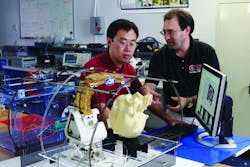A team of researchers, including PhD candidate Hao Su and Professor Gregory Fischer from the Automation and Interventional Medicine Robotics Laboratory at the Worcester Polytechnic Institute in Massachusetts, has developed a magnetic resonance imaging (MRI) compatible piezoelectric actuated robot that works inside a 3 Tesla, closed-bore MRI with real-time image guidance. The goal of the project is to improve the way prostate cancer is detected and treated.
Project Details
One of the main features of the robot is its needle driver, which enables the rotation and translational movement of the needle cannula — a flexible tube inserted into the patient's body cavity for MRI-guided diagnosis and therapy.
The needle driver has a needle guide sleeve, a collet locking mechanism and passive optical tracking fiducial frame. The robot's motor rotates the needle using the collet mechanism by way of a timing belt. This rotating needle reduces tissue damage during the biopsy process while enhance targeting accuracy.
Since the robot operates inside a 3-Tesla, closed-bore MRI machine with only a 500-millimeter cylinder diameter, there were a number of elements that had to be taken into consideration during the design process. Specifically, for the robot's mechanical system, the components had to be non-ferrous for the patient's safety during the radiation process, but also compact due to the very limited installation space.
Equipment Used
- igus Drylin T linear guide systems and iglide A200 plastic plain bearings
- Piezoelectric motor drivers
- Fiberoptic communication linking motor controller to robot
- 3 degrees of freedom Cartesian positioning module on robot
- Concentric tube driver module
Video
The video (at bottom of this page) shows control of the rotation and translation of the needle placement robot inside MRI. While this is being done, the team can visualize (in real-time — 2.5Hz) the needle insertion trajectory inside the gelatin phantom, which is similar to the interior of human body. For safety issues, the in-build video camera can be used to see the exterior of the phantom. "This is the first time we have been able to control the piezoelectrically actuated robot with minimal image artifact thanks to our custom-developed piezoelectric motor driver and the iglide plastic bushings and drylin linear guide system from igus," says Hao Su. "This video helps prove our concept that we can use this robot to perform intra-operative needle placement surgery (biopsy and brachytherapy) with real-time MRI image guidance."
Automation World would like to thank igus for connecting us with the Worcestor Polytechnic Institute team to make this "Engineering School Innovations" installment possible.
If you know of an engineering school project we should feature, contact [email protected].


